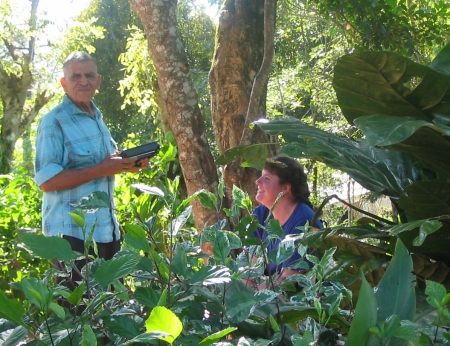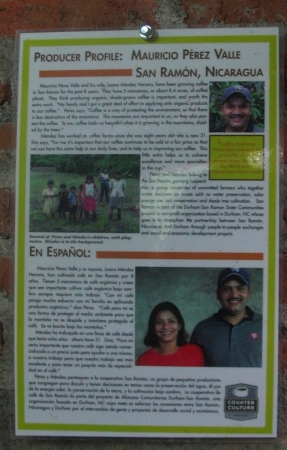Nicaragua Study Tour: Managua to Matagalpa
James Hayes-Bohanan, Ph.DBridgewater State College
Day 5: January 7, 2006
Nicaragua Study Tour: Managua to Matagalpa
James Hayes-Bohanan, Ph.D |
|
Introductory talk by CECOCAFEN, the Organization
of Northern Coffee Cooperatives, followed by travel to the
coffee-growing community of La Corona, a farm tour, and introduction to
host families
   The CECOCAFEN
offices also afford a nice view of the city of Matagalpa,
which our students enjoyed. Inside the office, we enjoyed a very
informative talk by Eddy, a top financial officer of the cooperative. The CECOCAFEN
offices also afford a nice view of the city of Matagalpa,
which our students enjoyed. Inside the office, we enjoyed a very
informative talk by Eddy, a top financial officer of the cooperative.Eddy has taught in Brazil, and speaks enough Portuguese to recognize that Brooks (the student shown talking to Eddy) and I both speak Portuguese better than we speak Spanish! |








 |
One of the great advantages of
fair-trade coffee is that it provides the growers with a lot of the
information that would normally only be in the hands of processors and
importers. This is why the "cupping" labs in Matagalpa are so very
important. (More on that topic later.) Fair trade also allows customers to make a more direct connection with the growers, which is ultimately the purpose of this entire trip. Both in Mauricio's house and in the house where Pam and I stayed with Dona Elsa, I found symbolic evidence of these connections. Our house had a label on the front door from Equal Exchange, the company in West Bridgewater, Massachusetts that showed fair trade could be done in the U.S. coffee market -- and that helped me organize this trip. Mauricio and his family are featured in an article I found on ther wall from Counter Culture, another fair trade company. |
 |
| Following our introduction to
the crop, Anivel led members of our group
to the homes where we would be staying -- a total of six families
hosted us in groups of two or three. Pam and I stayed with Dona Elsa,
who showed us a better way to make rice and beans (below, right). Her
son Alejandro is
another of the community's guides, and is a student of history and
geography at the university in Matagalpa. He is shown (below, left)
enjoying some
time with some of the delightful youngsters in this extended household.
We never did learn all of the relationships, but three generations live
in several houses that share a small plot of land and a few common
amenities. All of the host homes are identified by agro-ecotourism signs, indicating that the households have received some training and support as part of an educational and economic development program that connects farmers to people who are interested in coffee. |
 |

